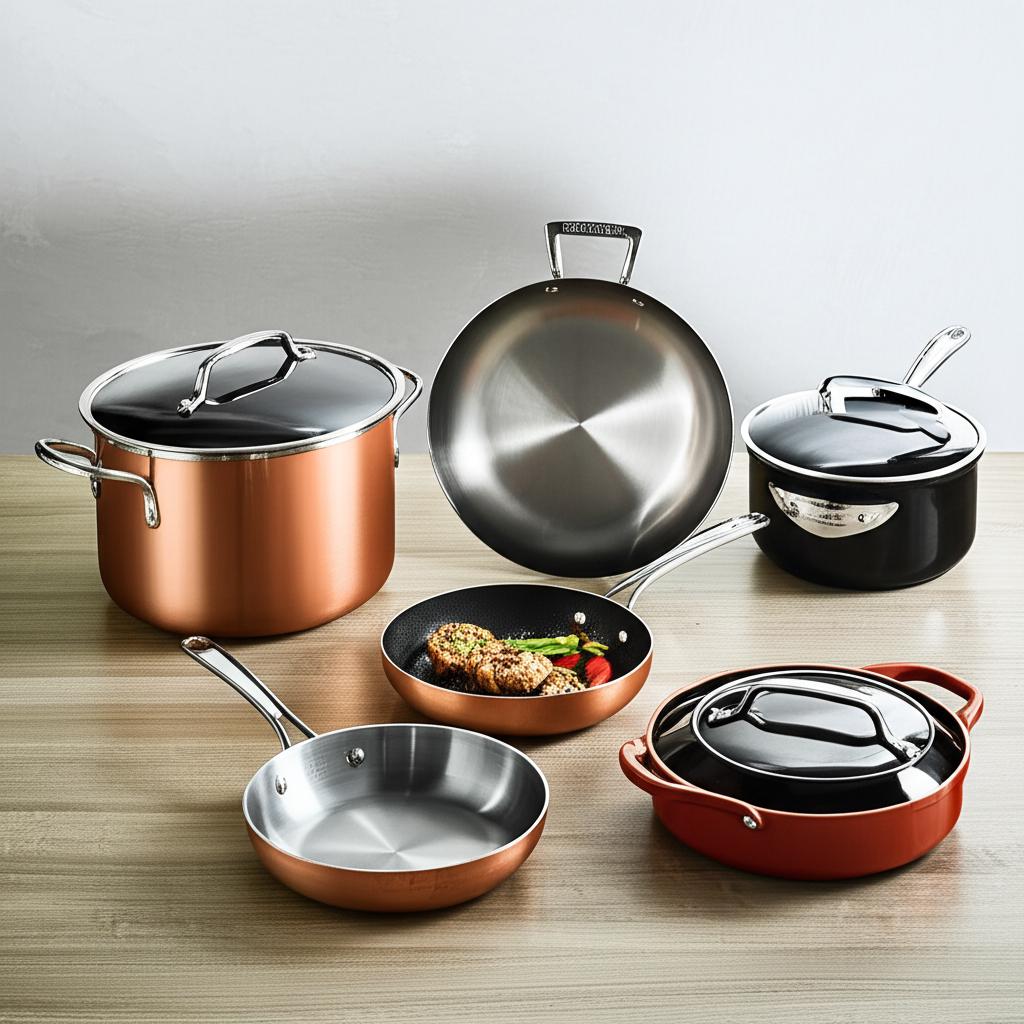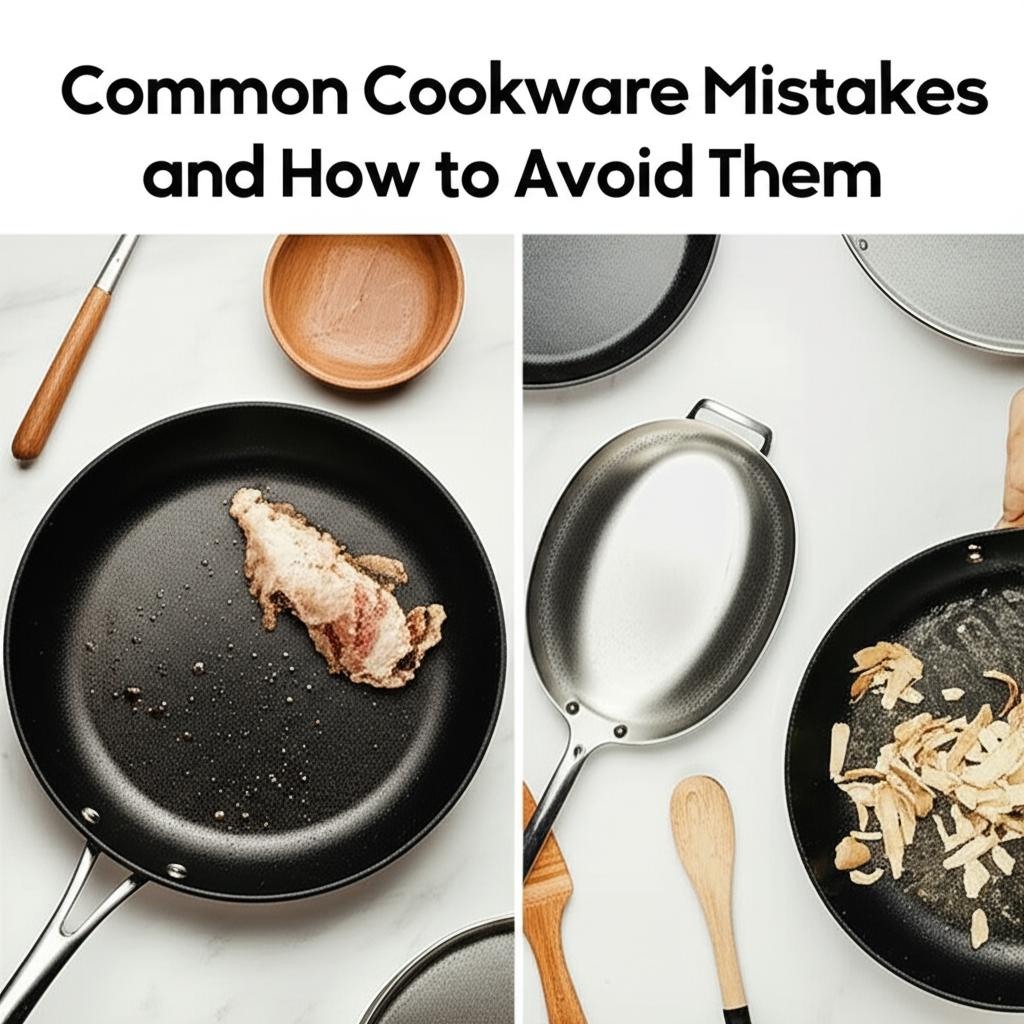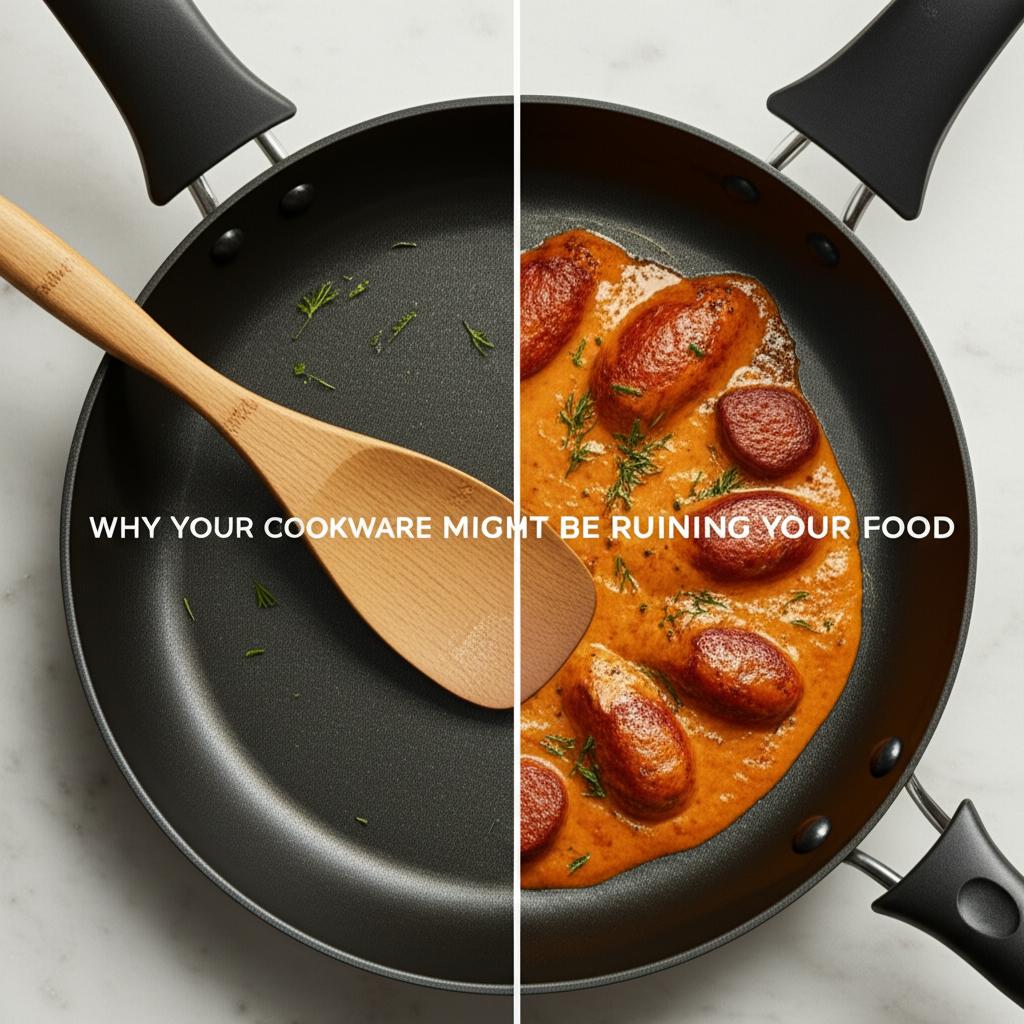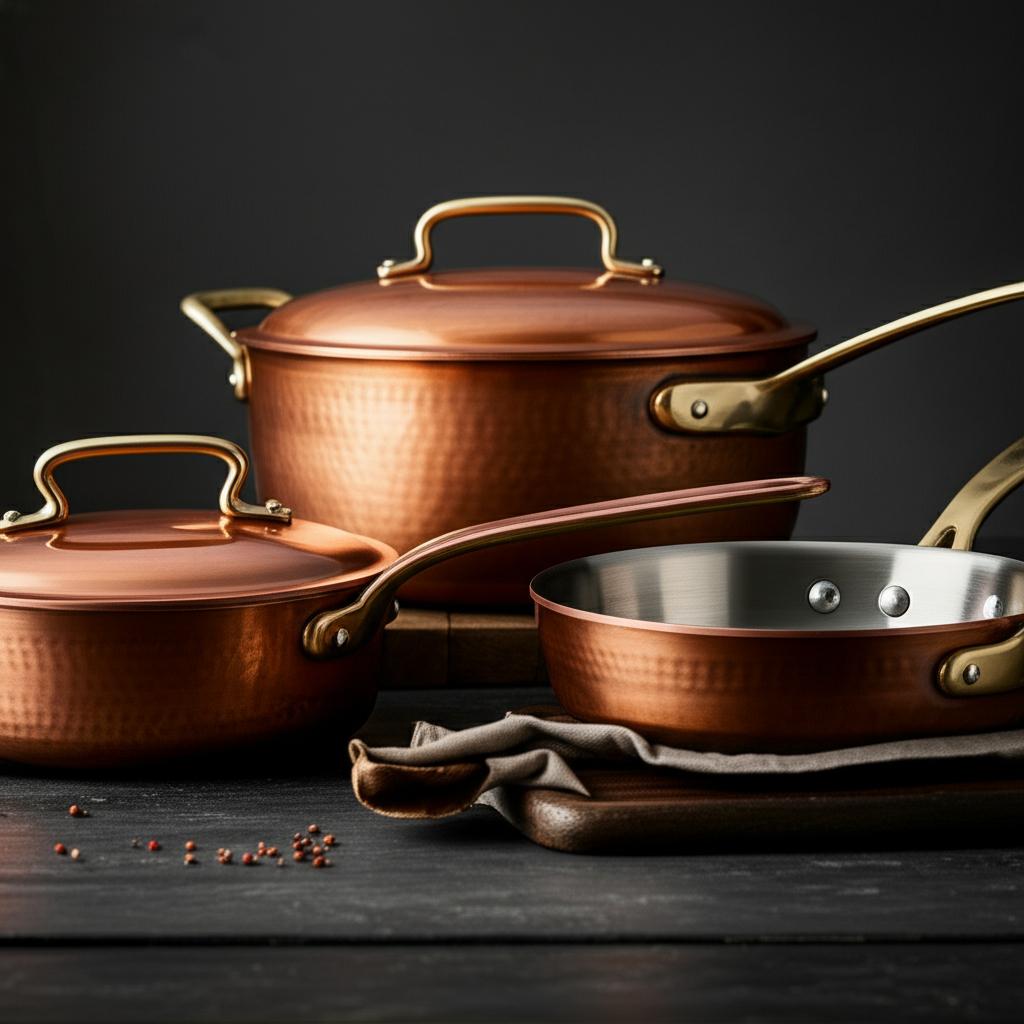
Why the Right Cookware Material Matters: Your Guide to Kitchen Success
- PriorityChef Wooden Spoons for Cooking, 8Pc with Utensil Holder, Non Scratch Bamboo Cooking Utensils, Non-Toxic Wooden Utensil Set, Easy to Clean Kitchen Utensils Set for All Cookware Types
- SNOWCLAD Pots and Pans Set Non Stick, 10 Pcs Hybrid Stainless Steel Cookware Sets, Non Stick Frying Pans, Saucepans, Saute Pan & Stock Pot, PFOA Free Kitchen Skillet,Induction Compatible
- CAROTE 3pcs Pots and Pan Set, Nonstick Induction Cookware Detachable Handle,Cookware Set with Removable Handle
Ever wonder why some dishes turn out perfectly browned and juicy, while others stick stubbornly to the pan or cook unevenly? The secret often lies not just in the ingredients or your skill, but in the very material of your cookware. Choosing the right pots and pans isn’t just about aesthetics; it’s a fundamental step towards consistent, delicious, and stress-free everyday cooking.
Let’s dive into why understanding cookware materials is a game-changer for your kitchen.
Why Your Cookware Material is a Big Deal
The material of your pots and pans directly influences how heat is distributed, how food interacts with the surface, and even how long your beloved cookware lasts. Here’s why it truly matters:
- Heat Distribution & Retention: Some materials heat up quickly but lose heat just as fast, while others take time to warm up but hold heat like a champion. Even heat distribution ensures your food cooks uniformly, preventing dreaded hot spots that burn one part while leaving another undercooked. Good heat retention means your pan stays hot even when you add cold ingredients, crucial for achieving that perfect sear.
- Reactivity with Food: Certain metals can react with acidic foods (like tomatoes, wine, or citrus), potentially imparting a metallic taste or discoloring your food. Non-reactive materials ensure the pure flavor of your ingredients shines through.
- Durability & Longevity: Investing in cookware made from robust materials means it will resist warping, scratching, and corrosion, lasting for years – even decades – of daily use. High-quality materials are built to withstand the rigors of everyday cooking.
- Ease of Cleaning & Maintenance: No one loves scrubbing! The right material can significantly cut down on cleanup time, offering stick-resistant surfaces or requiring simple wipes rather than strenuous effort.
- Health & Safety: While most modern cookware is safe, some materials are generally considered more inert and safer for long-term use, especially when cooking at high temperatures or for extended periods. Understanding this can offer peace of mind.
- Versatility: Some materials are incredibly versatile, performing well across various cooking methods and heat sources, while others excel at specific tasks. Matching the material to the task at hand is key to culinary success.
Understanding Common Cookware Materials
Let’s explore the characteristics of popular cookware materials and what they bring to your kitchen. Remember, we’re focusing on the properties of the materials, not specific brands or products!
-
Stainless Steel:
- The Workhorse: This is a kitchen staple for good reason. Stainless steel is incredibly durable, non-reactive, and resistant to corrosion and scratching. It’s also typically oven-safe and often induction-compatible.
- Heat Performance: It doesn’t conduct heat as well as some other metals on its own, which is why most quality stainless steel cookware has an aluminum or copper core sandwiched between layers (often called “tri-ply” or “multi-clad”) for superior heat distribution.
- Best For: Searing meats, sautéing vegetables, simmering sauces, boiling pasta, and any task where you need a durable, non-reactive surface. It’s excellent for building fond (the delicious browned bits at the bottom of the pan) for gravies and pan sauces.
-
Cast Iron:
- The Heat Retention Champ: Cast iron takes a while to heat up, but once it’s hot, it holds onto heat incredibly well and distributes it beautifully. Over time, with proper seasoning, it develops a natural, stick-resistant surface.
- Versatility: It’s incredibly versatile – perfect for stovetop searing, frying, baking in the oven, and even campfire cooking.
- Best For: Achieving a deep, beautiful sear on steaks, frying chicken, baking cornbread, slow-cooked dishes, and anything that benefits from consistent, high heat.
- Tip: Always preheat cast iron slowly and thoroughly for best results and to prevent warping.
-
Nonstick (e.g., PTFE-based, Ceramic Nonstick):
- The Convenience King: The primary benefit here is food slides right off with minimal oil, making cooking and cleanup incredibly easy.
- Heat Performance: Nonstick coatings are generally not designed for very high heat, as excessive temperatures can damage the coating and reduce its lifespan.
- Best For: Delicate foods like eggs, pancakes, crepes, fish fillets, and anything where sticking is a major concern.
- Tip: Always use low to medium heat with nonstick cookware and avoid metal utensils to protect the surface.
-
Copper:
- The Pro’s Choice for Control: Copper is an exceptionally responsive material, meaning it heats up and cools down almost instantly when you adjust the heat. This offers unparalleled control over cooking temperatures.
- Heat Performance: It conducts heat incredibly well and evenly.
- Best For: Delicate sauces, candies, precise temperature-controlled dishes, and experienced cooks who value precise heat adjustments.
- Note: Copper often requires a lining (like stainless steel or tin) because it’s reactive with some foods. It also tends to be more expensive and requires polishing to maintain its shine.
-
Carbon Steel:
- The Hybrid Performer: Often considered a lighter, smoother cousin to cast iron, carbon steel shares many of its benefits. It’s responsive, durable, and develops a natural nonstick seasoning over time.
- Heat Performance: Heats up faster than cast iron but still offers excellent heat retention, especially after seasoning.
- Best For: Stir-fries, omelets, searing, crêpes, and dishes where you want the benefits of cast iron with lighter weight and faster heating.
Choosing the Right Material for Your Dish: A Step-by-Step Guide
It’s not about having all the cookware, but having the right cookware for your most frequent cooking tasks.
Step 1: Consider Your Cooking Task.
* Searing/Browning: You need something that holds and distributes high heat well. Cast iron, carbon steel, and multi-clad stainless steel are excellent choices for achieving that delicious crust.
* Simmering Sauces/Soups: Non-reactive and even heating are key. Multi-clad stainless steel is perfect here, as it won’t impart flavors and maintains a steady simmer.
* Delicate Foods (Eggs, Pancakes, Fish): You want minimal sticking. Nonstick cookware is the clear winner for these.
* Stir-Frying: Rapid, high heat is essential. Carbon steel woks are traditionally preferred for their heat retention and ability to handle high temperatures.
* Baking/Oven Roasting: Oven-safe materials are crucial. Cast iron, stainless steel, and oven-safe ceramic-coated pots are great for finishing dishes in the oven.
Step 2: Think About Your Food.
* Acidic Foods (Tomatoes, Wine, Lemon Juice): Opt for non-reactive materials like stainless steel or glass/ceramic to prevent metallic tastes or discoloration.
* Sticky Foods: Nonstick surfaces are your best friend.
* High-Fat Foods: Most materials can handle these, but cast iron or stainless steel will give you a great sear.
Step 3: Match with Your Heat Source.
* Induction Cooktops: Require cookware with a magnetic base (typically cast iron, carbon steel, or specific stainless steel types). Always check for “induction compatible” if you have an induction stove.
* Gas/Electric Coils: Most materials work well, but heavy, flat-bottomed pans are best for electric coils to ensure maximum contact.
* Oven Use: Ensure handles are oven-safe (no plastic unless specified) and the material can withstand high oven temperatures. Cast iron and all-metal stainless steel are usually safe for high oven temps.
Step 4: Factor in Maintenance and Lifestyle.
* Dishwasher Safe? Many materials like stainless steel are, but cast iron and most nonstick coatings are not. Handwashing often extends the life of your cookware.
* Requires Seasoning? Cast iron and carbon steel need regular seasoning to maintain their nonstick properties. Are you willing to do this?
* Weight: Cast iron can be very heavy. Consider if you’re comfortable lifting heavy pans, especially when full.
Tips for Maximizing Your Cookware’s Performance
Even the best cookware needs a little love and proper technique to perform its best.
- Always Preheat Properly: Don’t just throw food into a cold pan! Allow your pan to heat up gradually and evenly before adding oil or food. This is especially true for stainless steel to prevent sticking.
- Use the Right Heat Level: High heat isn’t always better. Nonstick coatings perform best on low to medium heat. Save high heat for cast iron or carbon steel when searing.
- Choose the Right Utensils: Avoid metal utensils on nonstick surfaces as they can scratch the coating. Silicone, wood, or heat-resistant plastic are safer choices. For stainless steel, cast iron, or carbon steel, metal utensils are generally fine.
- Clean and Store Correctly: Always follow the manufacturer’s cleaning instructions. For cast iron and carbon steel, hand wash, dry thoroughly, and apply a thin layer of oil (re-season). Store pans carefully to prevent scratching, perhaps with pan protectors.
- Know When to Upgrade: Cookware isn’t forever. If your nonstick coating is peeling or scratched, or your pan is warped and won’t sit flat, it’s time to replace it.
Common Mistakes to Avoid
- Using High Heat on Nonstick Cookware: This is a surefire way to shorten its lifespan and potentially release fumes. Stick to low-to-medium heat only.
- Neglecting Seasoning on Cast Iron/Carbon Steel: Without proper seasoning, these pans will stick and can rust. Regular seasoning is crucial for their performance.
- Using Abrasive Cleaners or Steel Wool: Unless specified (e.g., to remove rust from cast iron), avoid harsh scrubbers on most cookware surfaces, especially nonstick and polished stainless steel, as they can damage the finish.
- Thermal Shock: Never plunge a hot pan (especially cast iron or nonstick) into cold water. Allow it to cool down naturally to prevent warping and damage to the material or coating.
- One-Size-Fits-All Mentality: Don’t expect one pan to do everything perfectly. Having a small collection of different materials for different tasks will elevate your cooking significantly.
Conclusion
Understanding why the right cookware material matters isn’t just about becoming a kitchen gadget expert; it’s about empowering yourself to cook better, safer, and with more confidence. By choosing the appropriate materials for your culinary adventures, you’ll unlock more flavor, achieve better textures, and make your time in the kitchen more enjoyable and efficient.
Armed with this knowledge, you’re ready to make informed decisions that will transform your everyday cooking from good to truly great. Happy cooking!
- PriorityChef Wooden Spoons for Cooking, 8Pc with Utensil Holder, Non Scratch Bamboo Cooking Utensils, Non-Toxic Wooden Utensil Set, Easy to Clean Kitchen Utensils Set for All Cookware Types
- SNOWCLAD Pots and Pans Set Non Stick, 10 Pcs Hybrid Stainless Steel Cookware Sets, Non Stick Frying Pans, Saucepans, Saute Pan & Stock Pot, PFOA Free Kitchen Skillet,Induction Compatible
- CAROTE 3pcs Pots and Pan Set, Nonstick Induction Cookware Detachable Handle,Cookware Set with Removable Handle
FAQ
Q. Why is cookware material so important for everyday cooking?
A. The material of your cookware fundamentally dictates its performance, directly impacting heat distribution, cooking speed, food release, and even the flavor and safety of your meals. Different materials excel at different tasks, making the right choice crucial for optimal results and a pleasant cooking experience.
Q. How does the material influence heat distribution and retention?
A. Materials vary significantly in their thermal conductivity. Copper and aluminum are highly conductive, heating up quickly and distributing heat very evenly, which prevents hot spots and ensures consistent cooking. Cast iron and heavy-gauge stainless steel, while slower to heat, excel at heat retention, keeping food warm and making them ideal for searing, frying, or slow simmering. This directly affects how evenly your food cooks and whether it browns or burns.
Q. Can the cookware material affect the taste or safety of my food?
A. Yes, certain materials can react with acidic foods, potentially leaching trace amounts or imparting a metallic taste (e.g., uncoated aluminum or unseasoned cast iron with tomato sauce). Modern non-stick coatings are generally safe, but older ones sometimes contained PFOA/PFOS, which are now largely phased out. Stainless steel and glass are non-reactive and considered very safe, making them excellent choices for all types of food.
Q. How does the material impact food release and ease of cleaning?
A. Non-stick coatings (like PTFE or ceramic) are specifically designed for easy food release and quick cleanup, making them perfect for delicate foods like eggs and pancakes. Well-seasoned cast iron also develops a natural non-stick surface over time. Stainless steel, while durable, may require more oil to prevent sticking and a bit more effort to clean if food chars on.
Q. Does the material affect the energy efficiency of my cooking?
A. Absolutely. Materials with excellent thermal conductivity, such as copper and aluminum, heat up quickly and transfer heat efficiently to food, potentially reducing cooking time and energy consumption. Materials with good heat retention, like cast iron, keep food warm longer, which can also contribute to energy savings by reducing the need for reheating or maintaining a high flame.
Q. What role does durability play in choosing the right material?
A. Durability determines the lifespan and resilience of your cookware against daily wear, high temperatures, and cleaning methods. Materials like stainless steel and cast iron are exceptionally durable, resistant to warping, denting, and scratching, offering decades of use. Non-stick coatings, while convenient, typically have a shorter lifespan and require more careful handling to prevent damage, making durability a key factor in long-term value.
Q. Is there a “best” cookware material for all types of cooking?
A. No single material is universally “best” for every cooking task. A well-equipped kitchen often benefits from a mix of materials. Stainless steel is incredibly versatile for most everyday cooking, while cast iron is unparalleled for searing and baking. Non-stick is indispensable for delicate foods that tend to stick, and copper is favored by professional chefs for its precise temperature control. The “best” choice is the one that aligns with your specific cooking needs and preferences.


